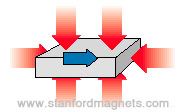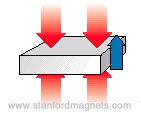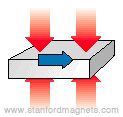Manufacturing Methods of Permanent Magnets
Permanent magnets of different materials (Neodymium, SmCo, ferrite, alnico, flexible) have different manufacturing methods. In this article we will focus on the various methods and their respective advantages and drawbacks.
Sintering (Rare-earths, Ferrites and Alnicos)
Rare-earth, ferrite and Alnico magnets can be manufactured with this method. The sintering process involves compacting fine powders at high pressure in an aligning magnetic field and then sintering to fuse into a solid shape. After sintering, the magnet shape is rough, and will need to be machined to achieve close tolerances. The intricacy of shapes that can be thus pressed is limited.
Pressing (Rare-earths)
Other than sintering, some Rare-earth magnets are manufactured by die pressing (with pressure applied in one direction) or isostatic pressing (with equal pressure applied in all directions). The aligning magnetic field for die pressed magnets can be either parallel or perpendicular to the pressing direction. Magnets pressed with the aligning field perpendicular to the pressing direction achieve higher magnetic properties than the parallel pressed form. Isostatically pressed magnets achieve higher magnetic properties than die pressed ones.
 |
 |
 |
|
Isostatic Pressing |
Parallel Pressing |
Perpendicular Pressing |
Pressure Bonding or Injection Molding (Rare Earths and Ferrites)
Both Rare-earth and Ferrite magnets can be manufactured by pressure bonding or injection molding the magnet powders in a carrier matrix. The density of magnet materials manufactured in this way is lower than that of the pure sintered ones, yielding lower magnetic properties. However, bonded or injection molded magnets may be machined into relatively intricate shapes with close tolerances "off tool".
Casting (Alnicos)
Alnico magnets can be manufactured with casting and sintering methods. Cast ones may be in large or complex shapes such as the common horseshoe while sintered ones are in relatively small sizes, normally one ounce or less, and in simple shapes.
Calendaring and Extruding (Flexible)
Flexible or Ferrite magnets are made by calendering or extruding magnet powders in a flexible carrier matrix such as vinyl. Magnetic properties of this type of magnet are even lower than the bonded or injection molded form. However, flexible magnets are easily cut or punched into different shapes.
Pre: Some Issues for Magnet Assemblies Manufacturing
Next: Different Magnet Functions and Examples of Applications







